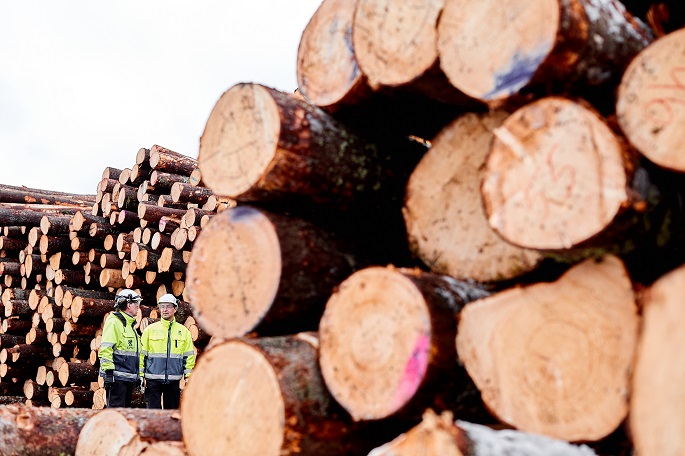Forest industries getting quick recovery but to slow down in 2022
Published : 17 Oct 2021, 00:56
The gradual improvement of the coronavirus pandemic and the continued economic recovery measures will be reflected in the global economy and will increase production and export volumes of forest industry products in 2021, said the Natural Resources Institute Finland (Luke).
In Finland, the growing demand for wood in industries will increase felling volumes and stumpage prices and improve employment and companies’ profitability.
According to the Finnish Forest Sector Economic Review 2021—2022 by the Luke, the increase in production and export volumes will decelerate in 2022.
During the coronavirus pandemic, demand for sawnwood has been stronger than expected. During the spring and summer of 2021, the prices of sawn softwood even reached record-high levels globally.
The export price of Finnish sawnwood has also risen steeply. The price peak has, however, already been reached in many markets, which will also be reflected in the development of the export price of Finnish sawnwood during the rest of the year.
Even though the export price will start to decrease, the average export price of sawnwood in 2021 is expected to increase by 38 per cent from 2020.
The high demand for sawnwood will increase the production of sawnwood in Finland to 12 million cubic metres in 2021.
At the same time, exports of sawnwood are expected to increase to 9.2 million cubic metres. Demand for sawnwood is also expected to remain strong in the export markets in 2022, while the average price of exported sawnwood is expected to decrease by roughly 20 per cent from 2021. The production and exports of sawnwood will continue to grow in 2022, as new sawing capacity is deployed.
The average price of exported plywood is expected to increase by five per cent in 2021 from the previous year, while export and production volumes will increase by almost 20 per cent. In 2022, the price of exported plywood and the export and production volumes are expected to decrease slightly from this year.
The economic growth has driven demand for paper to an increase in Europe after last year’s crash. The export volumes of Finnish paper have also recovered, and shutdowns of paper machines will have a lower impact than expected.
The production and exports of paper will slightly increase from the previous year, returning to a decrease next year due to the closure of the Veitsiluoto mill.
The export price of paper will increase by one per cent this year and next year as a result of improved demand, lower supply and increased raw material costs. The significant capacity cuts in Europe will clearly increase the operating rate of machinery from the previous year.
The growth in e-commerce has boosted the demand for paperboard products, and the demand is expected to continue to grow in the near future. In Finland, the production capacity of paperboard will increase this year after the production of kraftliner started at Stora Enso’s mill in Oulu, which will increase both the export and production volumes by 14 per cent. Next year, growth will be slower. Paperboard will pass paper this year as Finland’s most important forest industry product measured by the export value.
This year, pulp exports will increase by nine per cent from the previous year. This is based on the higher demand for end products made from pulp. Pulp exports will continue to increase next year, albeit more slowly than this year. The pulp price has been record-high globally, and the average export price of pulp will be 36 per cent higher than last year. The export price will decrease next year, while still remaining at a high level.
The wood market boomed again in 2021, driven especially by the excellent demand and price not only for sawnwood, but also for pulp in global markets. In 2021, industrial roundwood removals will increase to nearly 66 million cubic metres. The average stumpage prices of softwood logs will increase by 10–11 per cent and those of pulpwood by 4–6 per cent. Roundwood imports will increase slightly from the previous year.
In 2022, industrial roundwood removals are expected to remain close to the current year’s level. This is based on the removal of previously purchased standing invetories, the significant increase in the sawmill industry’s capacity, and the decrease in roundwood imports from Russia.
The average stumpage prices of softwood logs will decrease by 4–7 per cent in the wake of lowering prices of sawnwood. The decrease in pulp prices will reduce the stumpage prices of pulpwood by 3–4 per cent.
The export restrictions imposed based on Russia’s high export duties will put a stop to the imports of round softwood from Russia into Finland from the beginning of 2022. As the imports of birch pulpwood into Finland will also decrease, roundwood imports will drop by 12 per cent.
Growing felling volumes and rising stumpage prices will increase gross stumpage earnings from non-industrial private forests to EUR 2.2 billion in 2021. In 2022, gross stumpage earnings will decrease to EUR 2 billion due to lower stumpage prices.
As a result of the chilly first part of the year, the consumption of forest chips is expected to increase by two per cent this year and by four to five per cent next year. The discontinued use of energy peat and the growing prices of emissions rights will significantly increase the consumption of forest chips in the near future.
The consumption and production of wood pellets in Finland are expected to increase this year and next year, as new pellet plants are commissioned to replace fossil fuels.


